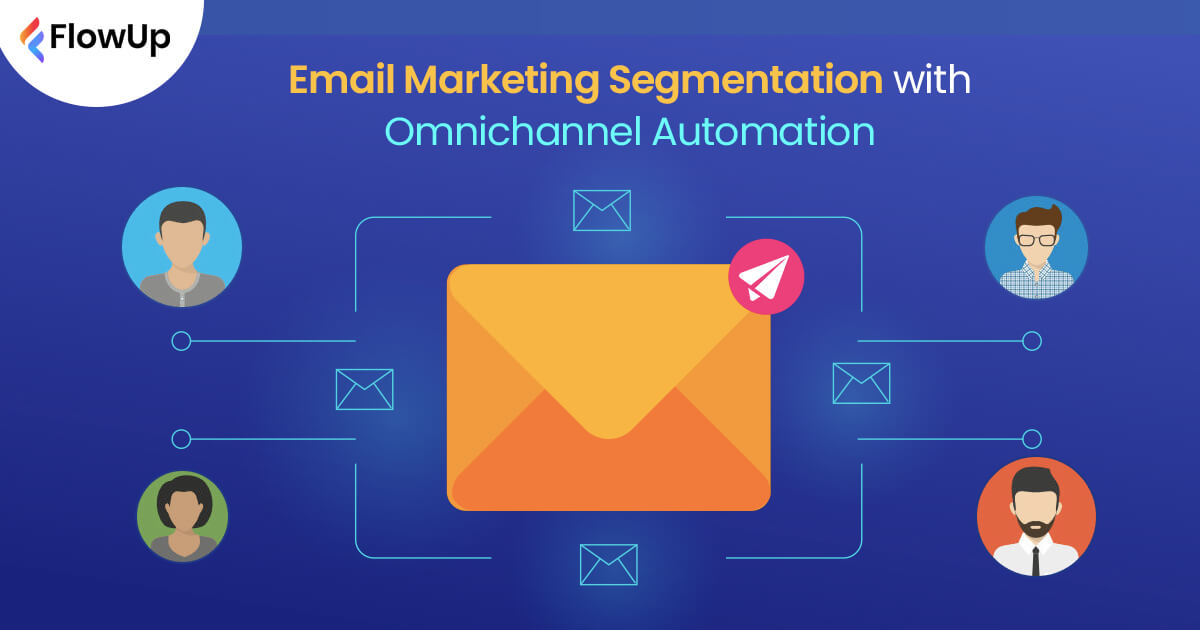In the constantly evolving digital marketing landscape, where customer attention spans are shrinking and their inboxes are overflowing, standing out can be a daunting challenge.
You might have all the makings of a successful email marketing campaign: a meticulously crafted strategy, a talented team, and a promising list of potential leads, and yet, the results aren’t living up to your expectations.
What if there was a way to break through the noise and truly resonate with each of your subscribers? A method that ensures your emails are tailored to their interests, delivered at the right time, on platforms they frequently use, and guides them smoothly along their buying journey?
Welcome to the world of email marketing segmentation with omnichannel automation.
Understanding Email Marketing Segmentation
Email marketing segmentation is more than a trendy buzzword; it’s an integral part of any successful email strategy. At its core, email marketing segmentation involves dividing your subscribers into distinct groups based on various factors. These could range from demographic information, purchase history, behavioral patterns, and customer preferences, among others.
This targeted approach to email marketing yields substantial rewards. By offering content that aligns with each subscriber’s unique interests and needs, you can significantly enhance open and click-through rates, increase customer engagement, and boost conversions. Consequently, you may notice a reduction in unsubscribe rates since who would want to opt out from receiving content that hits the mark every time?
However, without appropriate segmentation, you might encounter several roadblocks. Your carefully crafted emails might get lost in the torrent of messages filling your subscribers’ inboxes daily or, worse, in the dreaded spam folder. Irrelevant emails might cause subscribers to lose interest in your brand over time, jeopardizing your email marketing efforts.
The Significance of Segmentation in Email Marketing
1. Improved Relevance
By segmenting your email list based on specific criteria such as demographics, interests, purchase history, or engagement level, you can deliver highly relevant and targeted content to each segment. This relevance increases the chances of your emails resonating with recipients and encourages them to take the desired action.
2. Increased Engagement
When your emails are tailored to the interests and preferences of each segment, recipients are more likely to engage with your content. Segmented emails have higher open rates, click-through rates, and overall engagement than generic, one-size-fits-all emails. This increased engagement leads to better campaign performance and higher conversion rates.
3. Enhanced Personalization
Segmentation allows you to personalize your email campaigns by addressing recipients by their names, mentioning their specific interests or past purchases, and providing content that is highly relevant to their needs. This level of personalization creates a more personalized and meaningful experience for your subscribers, fostering stronger connections and building trust.
4. Targeted Messaging
With segmentation, you can craft targeted messages that speak directly to the unique needs, pain points, or preferences of each segment. This enables you to address specific customer segments with tailored offers, promotions, or recommendations, increasing the chances of conversion and customer satisfaction.
5. Better Customer Retention
By segmenting your email list and sending targeted content, you can nurture customer relationships more effectively. Segmented email campaigns enable you to deliver relevant information, updates, or exclusive offers to specific customer segments, fostering loyalty and encouraging repeat business.
6. Optimal Resource Allocation
Email marketing segmentation helps you allocate your resources more effectively by focusing your efforts on the segments that are most likely to respond positively. By understanding the unique characteristics and preferences of each segment, you can optimize your email marketing strategies and achieve a higher return on investment.
How Can Email Segmentation Gear Up Your Omnichannel Marketing Automation?
Email marketing segmentation is a powerful strategy that can significantly gear up your omnichannel marketing automation efforts. Here’s how it can help:
1. Targeted Messaging
By segmenting your email list based on specific criteria, such as demographics, interests, or purchase history, you can send highly targeted and relevant messages to each segment. This targeted messaging extends beyond email and can be applied to other channels in your omnichannel strategy. By delivering personalized and tailored content across multiple channels, you increase the effectiveness and impact of your marketing automation.
2. Seamless Customer Journey
Email marketing segmentation allows you to create a seamless customer journey across different channels. By understanding the preferences and behaviors of each segment, you can design automated workflows that deliver consistent messaging and experiences throughout the customer’s journey. This ensures customers receive relevant content at every touchpoint, increasing engagement and driving conversions.
3. Channel Integration
Email marketing segmentation can be integrated with other channels in your omnichannel marketing automation. By synchronizing your segmented email campaigns with channels such as Voice messages, Text Messages, or SMS ChatBots, you can deliver a cohesive and synchronized experience to your audience. This integration enhances the reach and impact of your marketing messages, increasing the likelihood of engagement and conversion.
4. Personalization at Scale
Segmentation allows you to personalize your marketing messages at scale. By leveraging customer data and segmentation criteria, you can automate personalized content and offers across multiple channels. This level of personalization builds stronger connections with your audience and increases the effectiveness of your marketing automation efforts.
5. Data-Driven Optimization
Email marketing segmentation provides valuable data and insights into customer behavior and preferences. By analyzing the performance of your segmented campaigns across different channels, you can gather insights to optimize your omnichannel marketing automation. You can identify trends, preferences, and areas for improvement, allowing you to refine and enhance your automation strategy for better results.
Conclusion
Email marketing segmentation empowers your omnichannel marketing automation by delivering targeted messaging, creating a seamless customer journey, integrating with other channels, enabling personalization at scale, and providing data-driven optimization. By leveraging segmentation across your marketing automation efforts, you can maximize the impact and effectiveness of your omnichannel campaigns.
Experience the power of personalized, omnichannel marketing automation with FlowUp. Connect with our experts now or write us at [email protected] for more insight.

